Guidelines for Authors - Springer Publishing
Guidelines for Authors - Springer Publishing
Guidelines for Authors - Springer Publishing
Create successful ePaper yourself
Turn your PDF publications into a flip-book with our unique Google optimized e-Paper software.
Author <strong>Guidelines</strong> <strong>for</strong> Clinical Lactation<br />
Clinical Lactation is a peer–reviewed journal summarizing recent advances in clinical care in the<br />
field of human lactation, and is the official journal of the United States Lactation Consultant<br />
Association. The aim of the journal is to advance clinical practice <strong>for</strong> lactation specialists who<br />
work in a variety of settings: hospital, private practice, WIC, and mother–to–mother–support<br />
organizations. The articles being solicited <strong>for</strong> Clinical Lactation are concise, readable reports<br />
that summarize issues related to clinical care, treatment innovations and applications. All<br />
articles should contain specific implications and suggestions <strong>for</strong> clinical practice. Suitable topics<br />
<strong>for</strong> submission include, but are not restricted to:<br />
Treatment innovation<br />
Treatment dilemmas<br />
Case presentations<br />
Implementation of specific programs<br />
Outcomes of policies or programs<br />
Papers should be consistent with the current evidence base (if applicable), and should<br />
constitute a substantive contribution to the professional literature on clinical lactation. All<br />
articles can be hyperlinked to videos, websites, PowerPoint slides, or other ancillary sources of<br />
in<strong>for</strong>mation.<br />
Types of Contributions<br />
Articles on Clinical Practice. These articles include process and program descriptions, clinical<br />
audit and outcome studies, and the presentation and description of original clinical practice<br />
ideas. These articles should generally not exceed 2,000 words (approximately 8 pages of<br />
double–spaced text), not including references, and should be written in a readable, user–<br />
friendly style.<br />
Brief Reports of Research Findings. Brief reports of research findings are concise reports of<br />
new research. These articles are limited to 2,000 words, not including references and must<br />
have direct clinical relevance. These reports can be hyperlinked to other documents or websites<br />
with additional in<strong>for</strong>mation.
Brief Literature Reviews. Brief literature reviews are concise articles on a highly specific topic<br />
related to clinical practice, ending with applications <strong>for</strong> practice. These manuscripts are also<br />
limited to 2,000 words (8 pages of double–spaced text).<br />
Case Reports. Case reports offer clinicians a <strong>for</strong>um to share an interesting case, with the<br />
implications <strong>for</strong> broader clinical practice. These reports will typically range from 3–5 manuscript<br />
pages (750–1250 words).<br />
Letters to the Editor. Letters and responses pertaining to articles published in Clinical Lactation<br />
or on issues relevant to the field, brief and to the point, should be prepared in the same style as<br />
other manuscripts (250–300 words).<br />
Manuscripts and Other Requirements<br />
1. <strong>Authors</strong> should submit their manuscript and supporting files (tables, figures) using<br />
Editorial Manager at www.editorialmanager.com/clinlact.<br />
2. Place authors’ names, positions, titles, place of employment, mailing addresses, and<br />
email addresses on the cover page so that the manuscripts may be reviewed<br />
anonymously, and ensure that the manuscript uploaded to the Editorial Manager site is<br />
blind.<br />
3. Manuscripts should be professionally prepared in accordance with the Publication<br />
Manual of the American Psychological Association, 6 th edition.<br />
4. An abstract of approximately 125 words should be included.<br />
5. <strong>Authors</strong> should also supply a list of four to six keywords, not appearing in the title,<br />
which will be used <strong>for</strong> indexing. Terms from the medical subject headings (MeSH) list of<br />
Index Medicus should be used, if at all possible.<br />
6. Double-space everything, including references, quotations, tables, and figures.<br />
7. Leave generous margins (at least one inch all around) on each page.<br />
8. Type should not exceed 18 characters per inch.<br />
9. Avoid footnotes whenever possible.<br />
10. Quotations of 300 words or more from one source require written permission from the<br />
copyright holder <strong>for</strong> reproduction. Adaptation of tables and figures also requires<br />
reproduction approval from the copyrighted source. It is the author’s responsibility to<br />
secure such permission, and a copy of the publisher’s written permission must be<br />
provided to the publisher immediately upon acceptance of the manuscript <strong>for</strong><br />
publication.<br />
11. All figures must be submitted in camera-ready <strong>for</strong>m. TIFF should be 300 ppi, EPS at 800<br />
ppi.<br />
Note: <strong>Authors</strong> bear full responsibility <strong>for</strong> the accuracy of references, quotations, tables, and<br />
figures. Upon acceptance of the article, authors are expected to fill out the copyright<br />
agreement <strong>for</strong>m and mail it to the publisher at mlarkin@springerpub.com.
















